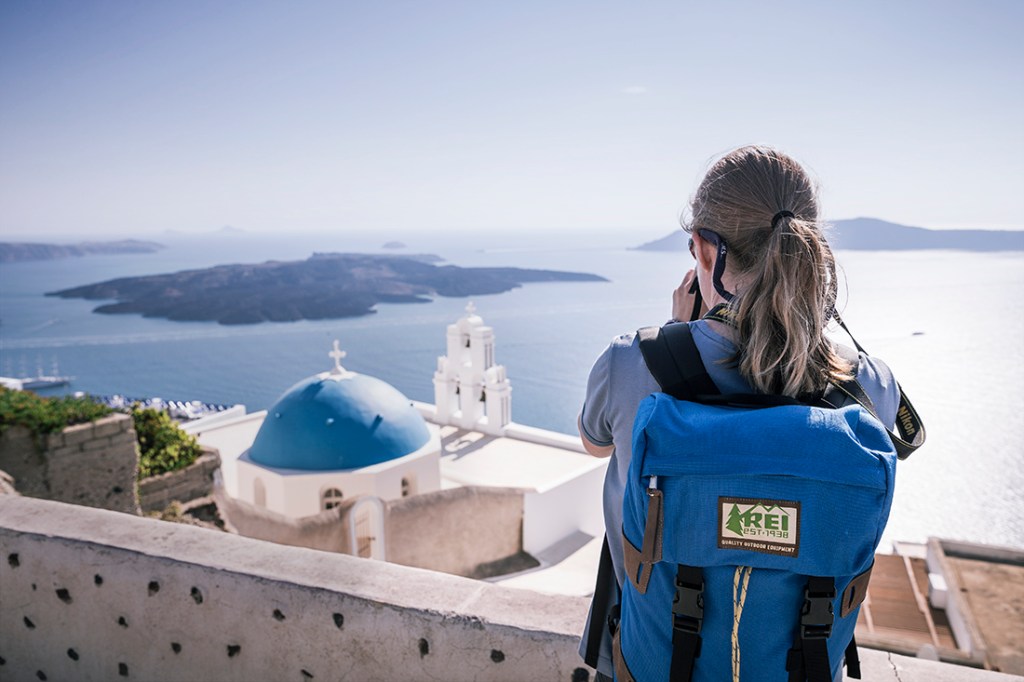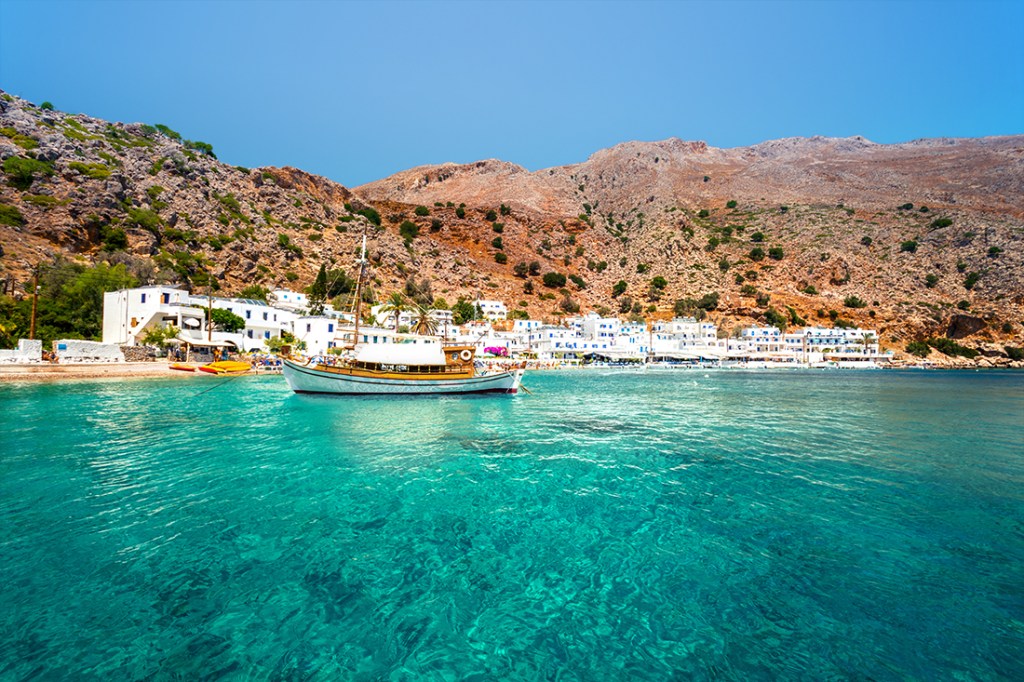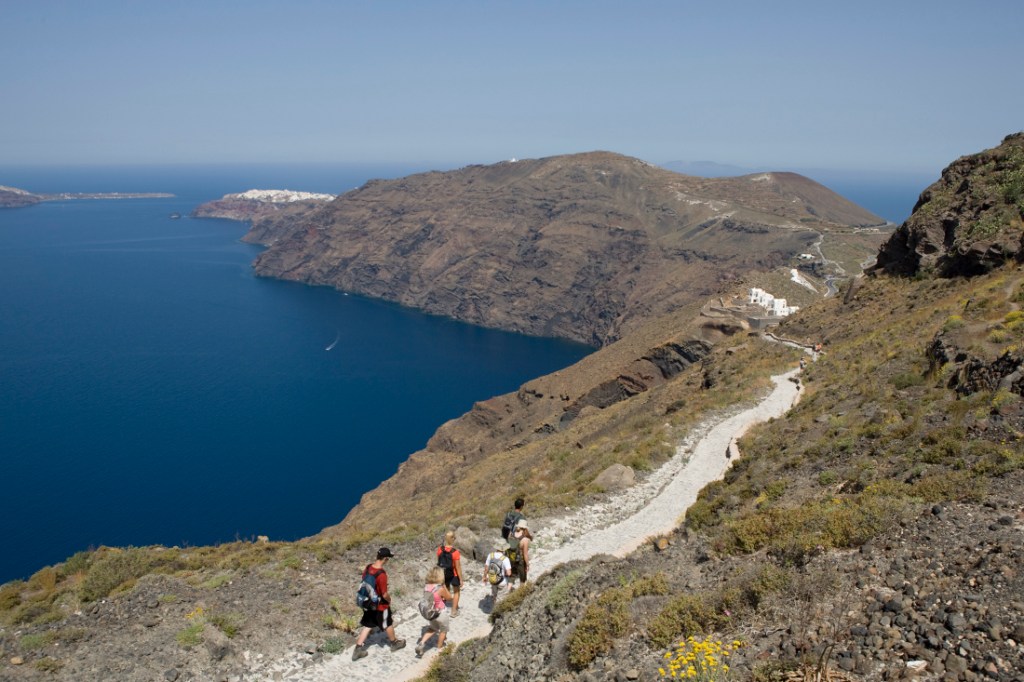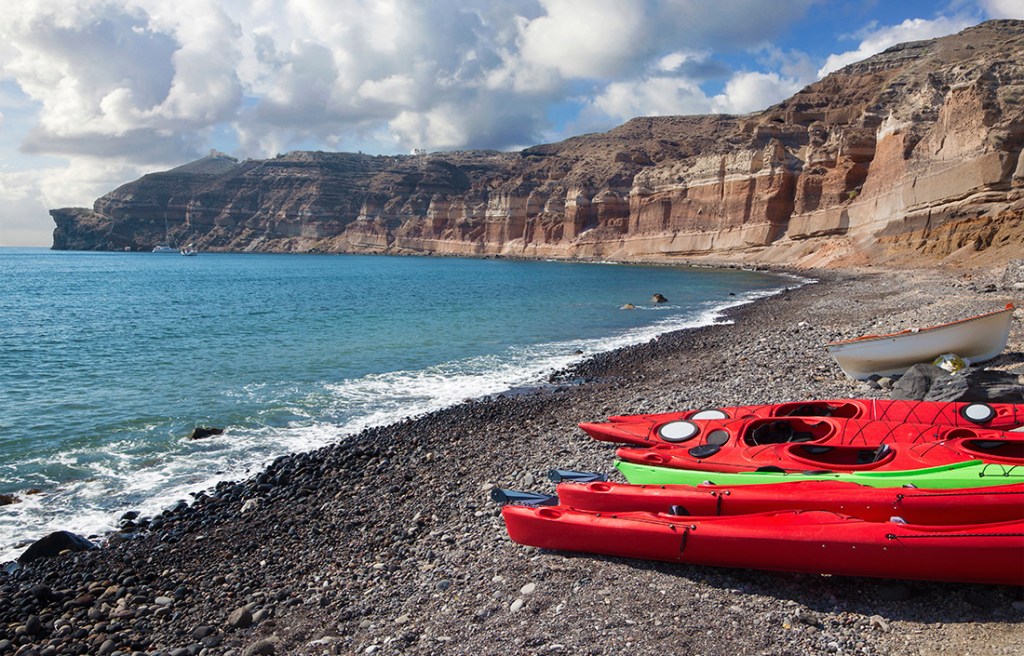Scattered throughout the bright blue waters of the Mediterranean, the Greek Islands are home to dramatic coastlines, romantic villages and a rich, complex history. Indeed, these isles—straight out of myth—offer unparalleled opportunities for adventure, relaxation and plenty of gastronomical indulgences.
A trip to the Greek Islands holds infinite possibilities, and navigating the variety can feel overwhelming. Whether you’re looking for an island-hopping adventure, a sun-soaked week on the beach or a deep dive into history, this travel guide will help you plan your ultimate trip.
If you’re just beginning to look into an adventure in the Greek Islands, this guide includes:
- Why Visit the Greek Islands?
- Top Destinations in the Greek Islands
- Top Outdoor Activities in the Greek Islands
- How to Plan Your Trip

A traveler takes in the sights and sounds of Santorini.
Why Visit the Greek Islands?
The Greek Islands feature an incredible depth of terrain, culture and activities for all kinds of travelers. White, sandy beaches, aquamarine seas, jagged volcanic rock formations and lush, rolling hills boast fantastic opportunities for hiking, kitesurfing, rock climbing and diving.
History shines brightly in the many archaeological sites found around the islands, and it would be easy to spend years in the Mediterranean, exploring the stories behind each one. Due to the central location between Europe, North Africa and the Asia Minor coast, the Greek Islands have been passed between empires since the birth of civilization. Explore Bronze Age palaces built by the Minoans, or peek into the intellectual legacy of the Ottoman Empire—even those who don’t consider themselves history buffs will be fascinated by the stories before them.
And to top it all off, the Greek people are known for their unconditional hospitality and quickness to a warm smile, even if the language barrier makes it hard to communicate. Time will slow down as you slip into the comfortable, laissez-faire lifestyle of the Greek Islands, sampling street food and local wine in the company of old and new friends. Many say a trip to Greece is something everyone should do at least once in their life, but then that raises the question—why just once?
Top Destinations in the Greek Islands
Civilization on the Greek Islands reaches far into the dark corners of history books, and each island is proud to have its own history, mythological stories and cuisine. Eight distinct groups of islands take up their fair share of the Mediterranean, stretching from the Ionian Sea all the way around the Greek mainland to the Asia Minor coast—there are over 6,000 islands and inlets, 227 of which are inhabited. This guide highlights some of the best areas to travel, but don’t be afraid to stray from the more popular islands—wherever you go, you’ll surely encounter striking scenery and warm, friendly people.
Cyclades Islands
By far the most visited group of islands in Greece, the Cyclades are easy to reach from Athens and boast a variety of activities for all kinds of travelers. Santorini is quaint and picturesque, with blue shutters and whitewashed houses jumbled over the volcanic hillside. Naxos boasts rugged terrain with high mountains and lush, green hillsides. Tinos is the religious center of the country, a holy place of pilgrimage for Orthodox Christians.
Akrotiri (Santorini)
Referred to as Minoan Pompeii, Akrotiri is the excavation site of a prosperous Bronze Age settlement, completely buried in volcanic ash from the catastrophic Thera eruption in 1646 B.C.
It wasn’t excavated until 1967, revealing remarkably well-preserved buildings, frescoes, pottery and furniture that will take you right back to ancient life in the Cyclades.
Mount Zas (Naxos)
The highest point in the Cyclades, Mount Zas is believed in Greek mythology to be the birthplace of the god Zeus. The 5-mile hike is moderate and pleasant, following a jagged limestone path that leads up to a rocky 3,290-foot summit. There’s not much shade as you get higher up, so try to start early to avoid the strong afternoon sun.
Nea Kameni (Santorini)
Nea Kameni is a small volcanic island in the center of the Santorini caldera, with nearby hot springs and great opportunities for diving. Hike up to the panoramic vista along the crater rim—expect a heavy whiff of sulfur—and then reward yourself with a dip in the bubbling waters of Palea Kameni, a small islet next to the volcano.
Tinos Town (Tinos)
One of the most important places of pilgrimage in the Greek Orthodox religion, the Church of Panagia Evangelistria draws visitors to the island every spring to visit its icon of the Virgin Mary. While the church is Tinos crown jewel, Tinos also has a longstanding artistic tradition, with spectacular marble architecture scattered throughout the surrounding villages.
Delos
A quick ferry ride from Mykonos, the uninhabited island of Delos is a UNESCO World Heritage site that offers an intimate look into the heart of ancient Greek civilization. Delos is the mythical birthplace of Apollo and Artemis, and temples, statues, well-preserved artifacts and a large amphitheater give you a taste of what life was like during the 7th century B.C. With just a humble cafe, small port and lack of a permanent population, Delos is a no-frills outcropping in the center of the Cyclades that lets history speak for itself.
Crete
Crete is the largest of the Greek Islands, a universe of its own that balances the natural beauty of wild mountain landscapes, a rich, complicated history and glamorous white-sand beaches.

Accessible by only foot or boat, the village of Loutro in southern Crete is a great stopover for solitude and outdoor adventure.
Agia Irini Gorge
The 4.5-mile hike through the Agia Irini Gorge is bursting with flora and fauna, a pleasant alternative to the hordes of tourists in the nearby Samaria Gorge. The one-way path is mostly downhill, wandering through pine trees, oak trees, cypresses and occasionally Cretan wild goats, before returning to Sougia, a quaint beach town on the southern coast.
Palace of Knossos
Extensive and imaginative restorations of the Palace of Knossos highlight the grandeur and sophistication of the ancient Minoan society during the Bronze Age. Wander through the lavish royal apartments, take in large, colorful frescoes and imagine King Minos himself giving orders in the lavish and extensively restored throne room.
Historic Chania
Originally a colony of the Venetians, and subsequently the Ottoman Turks, the old town of Chania is a charming labyrinth that showcases an evolving history. A stroll along the Venetian harbor with a morning cup of coffee elicits a remarkable similarity to the iconic Italian city.
Loutro
Only accessible by foot or boat, the picturesque fishing village of Loutro sits in a quiet marina on the south side of the Cretan coast. Isolated pebble beaches and charming seaside tavernas offer a quiet escape from summer crowds, and nearby castle ruins round out a full day of activities.
Dodecanese Islands
Known to be the sunniest corner of Greece, the Dodecanese region bumps right up to the Turkish Riviera, with opportunities for city wandering, scenic hikes and poolside relaxing. Like the rest of the surrounding islands, the Dodecanese fell under the control of multiple empires, with remnants of Byzantine, Ottoman and Venetian occupation scattered throughout.
Kalymnos Limestone Cliffs
With over 2,000 bolted routes on high-quality limestone, Kalymnos has emerged as one of the top sport-climbing destinations in the world. Unforgiving overhangs and steep crags draw expert climbers, while plenty of lower-grade routes are accessible for beginners.
Rhodes Old Town
Surrounded by medieval walls, the Old Town of Rhodes is a fantastic place to get pleasantly lost among the dizzyingly narrow cobblestone streets. A walk through the Street of Knights takes you right back to the 14th century when ironclad soldiers from seven different countries marched to their own respective lodges.
Plaka Forest (Kos)
Pine trees and cool water offer a shady escape from the beating Mediterranean sun in the Plaka Forest. Nature trails, picnic tables and wild peacocks roaming about make for a relaxing and family-friendly afternoon activity.
Top Outdoor Activities in the Greek Islands
1. Hiking
Hiking around the Greek Islands can mean anything from cobbled footpaths between villages to remote treks deep into the wilderness. Many of the footpaths between towns were built during ancient times, but they’ve been incredibly well-maintained. The 6.6-mile hike between Fira and Oia in Santorini is one that lives up to its fame. “Hiking along the caldera is absolutely stunning, and ending in the picturesque, whitewashed village of Oia is almost always everyone’s favorite part of the trip.”

Hikers traverse a coastal trail between Fira and Oia. Many islands in Greece are sparsely vegetated, so bring a hat!
The steep mountains and lush, rolling hills of Crete offer a huge variety of hiking terrain as well. You can get really high up in the White Mountains or right down to trails along the beach.
The E4 Path is a part of the extensive European long-distance trail network that crisscrosses countries all over the continent. It spans across the entire length of Crete, winding through each of the island’s distinct mountain ranges, as well as down to the sandy coast. Most of the well-known hiking trails, such as the Agia Irini and Samaria gorges, are found along the E4 Path, as well as the challenging crossing of the desolate White Mountain desert.
2. Diving
Colorful reefs, shipwrecks and deep caves provide a lifetime of underwater exploration off the coast of the Greek Islands. Dive sites in the Cyclades are home to some of the most iconic wreckages in the Mediterranean, with plane and shipwrecks right off the coasts of Naxos, Mykonos and Santorini. Off the southeast coast of Mykonos, the Anna II wreck site is a sunken 200-foot cargo ship surrounded by colorful sponge-filled reefs. A quick boat ride from Santorini takes you to the Nea Kameni site, where the 1975 Santa Maria ship rests, engulfed by underwater lava tubes and ominous caves.
Crete’s Shinaria Beach is abundant with marine life, a great option if you’re also traveling with non-divers. The beach has excellent opportunities for snorkeling and swimming, with colorful fish, octopus, sea turtles and manta rays as you dive deeper below. El Greco Cave is a popular site for experienced divers to try cave diving for the first time. The well-lit cavern is nearly 100 feet in length, filled with giant stalagmites and stalactites that host a diverse group of sea life.
3. Kayaking
Paddling around in a kayak is an exciting way to explore remote beaches and view the dramatic coastlines from a new perspective. The southern shore of Crete has some of the best opportunities for kayaking, with plenty of coves filled with hidden beaches and villages only accessible by paddling or hiking.

Kayaks sit at the ready on the southern flank of Santorini.
You can kayak to Loutro, a small, remote fishing village that’s inaccessible by car. Or head to Milos, another Cycladic island popular for kayaking, with huge arches, aesthetic coastlines and caves you can paddle into. Sarakiniko Beach, on the north shore of the island, is an excellent place to paddle around, with smooth, undulating volcanic rock that looks like a lunar landscape. Be sure to bring snorkeling gear with you, so you can hop out and explore the caverns and clear waters below.
4. Rock Climbing
Over the last two decades, the sleepy island of Kalymnos has created quite the buzz among international climbers. With solid limestone and over 66 sport crags—many of which are right off the beach—Kalymnos is a climber’s paradise.
Karpathos, an island just east of Crete, is a lesser-known climbing destination that’s begun to see a quiet influx of climbers since 2010. You’ll find the same overhangs and limestone walls that you will in Kalymnos, with a fraction of the crowds. There are six main crags around the island and nearly 250 sport routes, with grades ranging from beginner to expert.
Crete’s steep gorges offer excellent opportunities for cragging, with long routes and tons of variety, including slabs, chimneys, overhangs and cracks. Kapetaniana and Agiofarago are the two most popular climbing areas in Crete, located near the southern coast and only about an hour’s drive from the capital, Iraklia. Kapetaniana, located around a small, 80-person village on the hillside, has over 130 routes to suit many styles of climbing. Agiofarago is situated in a stunning gorge that opens up to the ocean, with climbing on both sides of the gorge depending on where the sun hits.
5. Kiteboarding
Prevailing winds combined with long, sandy beaches and warm, clear waters make the western coast of Naxos a haven for kiteboarders of all levels. In fact, due to the strong Meltemi wind, it’s consistently the windiest spot in Europe. Glyfada Beach is a half hour outside of Naxos town, an enormous stretch of beach surrounded by rolling sand dunes, juniper trees and, of course, relentless gusts of wind. The Naxos Kitesurf Club is right along the beach and offers instructional classes, as well as rentals for veteran surfers.
Theologos Beach on the northern coast of Rhodes is another favorite for kitesurfing, with a long, narrow beach that has plenty of opportunities for beginners. Rental shops along the water make it easy to pick up equipment for the day, and because the beach faces north, the winds always blow you back to shore so you don’t have to worry much about getting blown out to sea. Winds are typically strongest midday, so mornings are best for beginners looking to get their legs under them.
How to Plan Your Trip
Best Time to Visit
Midsummer is high season in the Greek Islands, with the bulk of travelers visiting from late June through early September. The water is warm, streets are busy and ferries run the most regularly in the summer. Temperatures are slightly cooler in the spring and fall, but the islands are still in full swing and it’s easier to keep your itinerary flexible since you won’t be competing for reservations.
If you’re planning to visit in the winter, do some research to see what’s open and which ferries are running. Many places shut down from November through early April.
Where to Stay
Lodging in the Greek Islands ranges from glitzy five-star hotels to backpacker hostels and everything in between. Due to a struggling economy, many hotels in Greece are quite affordable, but it’s important to make reservations in advance during the high season. Family-owned bed and breakfasts are a great middle ground, and the owners are often excited to share local tips and recommendations.
How to Get Around
The ferry system in the Greek Islands can get you almost anywhere you need to go. If you’re planning to island hop, it’s a good idea to choose a region and stick to the islands nearby—otherwise, you could easily surrender half your trip to long ferry rides. Most of the major routes run multiple times a day in the summer, but be sure to keep a ferry schedule on hand.
Due to long, inconvenient travel times, some areas are more popular to fly between. For instance, if you’re traveling to Crete from Athens, the 45-minute flight is quicker (and often more cost-effective) than a 6.5-hour ferry ride. Many of the larger islands have domestic airports and are easy to connect to from the mainland.
What to Eat and Drink
Simple, fresh and flavorful ingredients steal the show at the Greek table. Each island has its own local delicacies, ranging from rich sheep and goat milk cheeses to juicy tomato fritters to fresh seafood. It’s traditional in Greece to eat family style, with plenty of sharing plates so no one leaves the table without getting at least a bite of each dish.
A bowl of thick Greek yogurt with local honey is a delicious way to start your day, washed down with a strong cup of Greek coffee. At lunch and dinner, look for classics like grilled seafood (Greeks say that the best fish always comes with the head on), lamb, moussaka and various types of meatballs and stuffed vegetables. Meals almost always begin with meze (appetizers) with an array of tzatziki, fava bean dips, dolmades (stuffed grape leaves), bread and olive oil to share. Even the street food is tasty and fresh. A gyro wrap usually costs just a few euros—a hearty pita stuffed with rotisserie meat, onions, tomato, tzatziki and a few chips (fries)—and makes for a great lunch on the go.
Before you leave, be sure to nab a small (but strong) taste of raki, a Cretan spirit made from distilled, highly-concentrated grapes that’s traditionally sipped as an aperitif. Commonly made in the fall right after the grape harvest, raki goes hand in hand with Cretan tradition—many families have been distilling it together for generations and will proudly share a small glass with you after dinner.
To satisfy your sweet tooth, look for loukoumades, the Greek version of a doughnut hole, deep-fried and traditionally drizzled with honey and cinnamon. But of course, no trip to Greece is complete without indulging in a square of baklava, a sweet, melt-in-your-mouth pastry with syrupy honey, and pistachios or almonds between flakey layers of phyllo dough.
